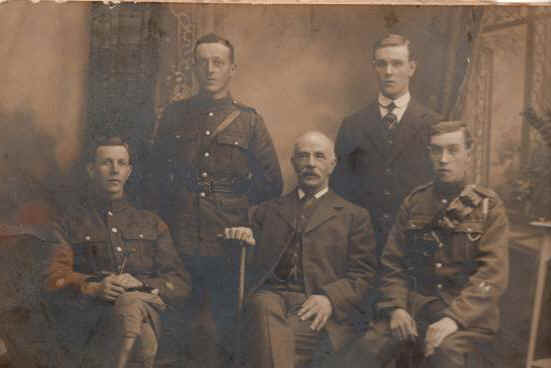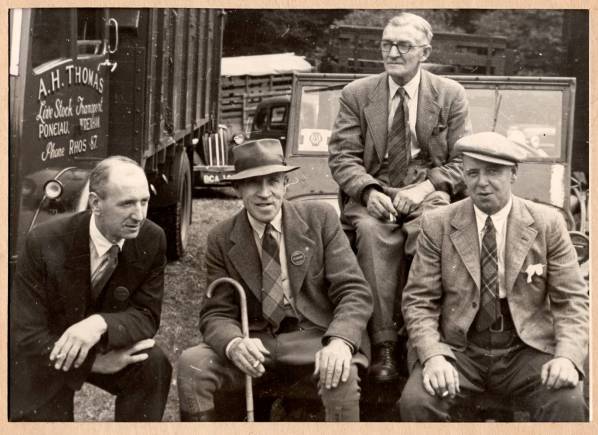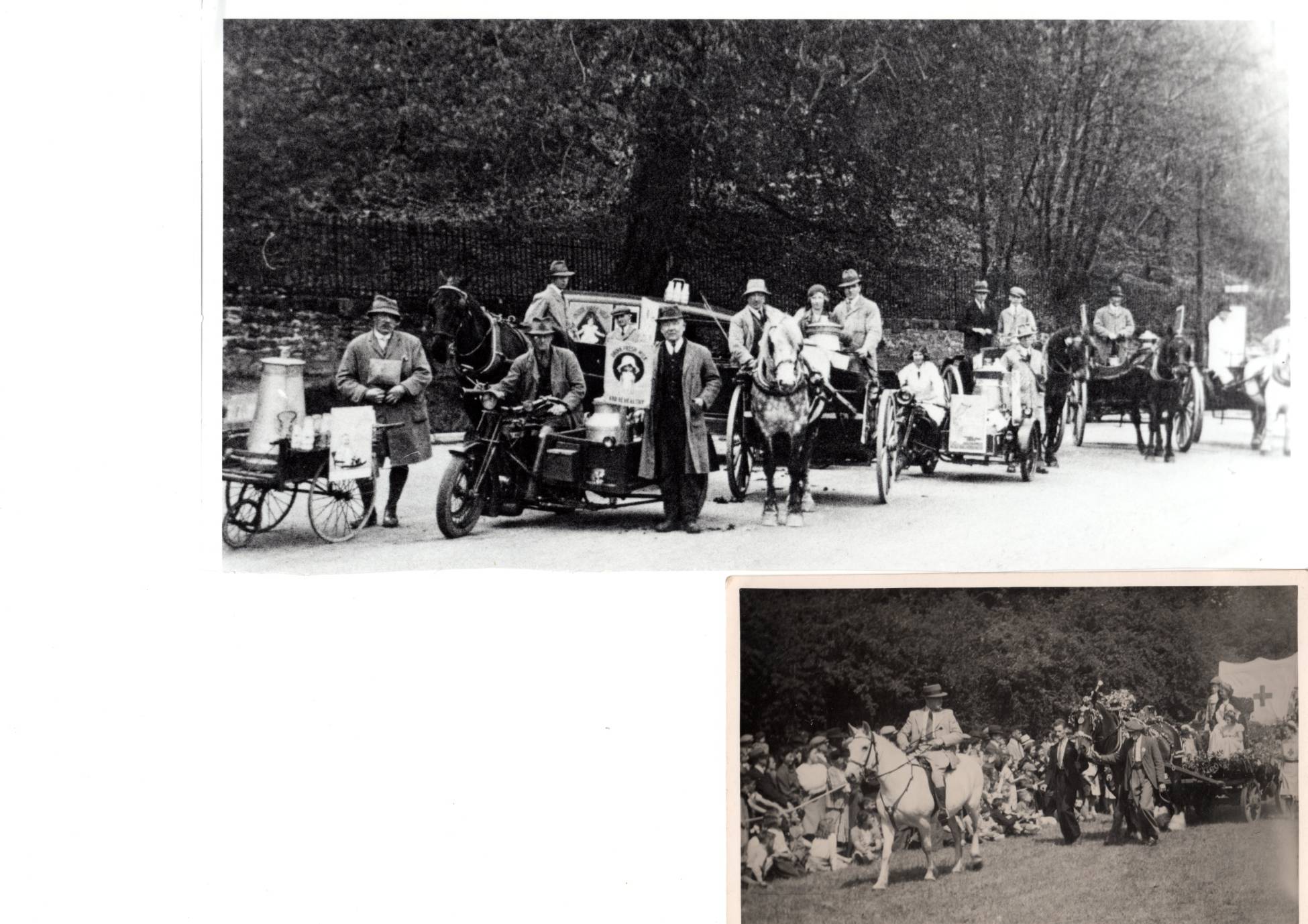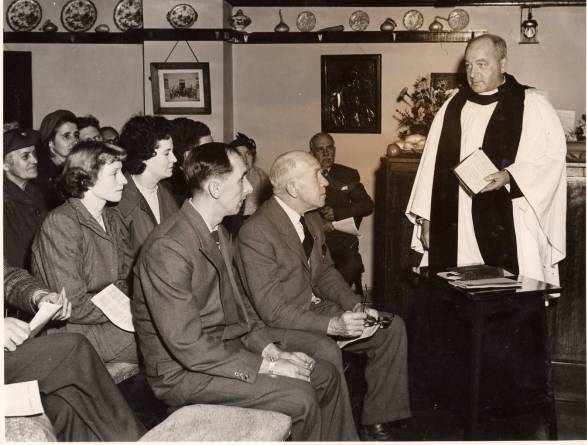Charles Williams
I met Charles, who was born 1927, and his wife, Florence, at
their home in Llangollen.
He, known locally as "Charles the Wern", met
Florence outside the snack bar by the Royal Hotel, where Fouziís now stands.
She and her friend were stuck in town as their lift home had failed to turn up.
Charles, knowing her friend, offered her a lift home, got a ride on John Jonesís
motor bike up to the Wern, borrowed his fatherís Landrover and took her home.
The courtship continued, helped by waves though the window, and trips down to
street level from where Florence worked in the Eisteddfod office in the Eifion
Building (now Bensons) to order or collect the milk from him..They were married
at Llantysilio Church in 1956, in spite of her doubtful words to her friend at
their initial meeting "Who is he?
Florence had been brought up in Hawarden, but at this time
lived at Rhewl, past the Sun Inn, in a house called Cymmo.
Charles Williams said, "My Father was Arthur Lloyd
Williams, who was the youngest of the nine surviving children of Charles
Williams, (Charles the Coal) and Ann (nee Smith). There were four boys and five
girls. He was born at Royal View, a house built by Charles, his father pre 1896,
on the foundations of a building used for cattle.

Elsie- Married a school teacher- lived Inverness Ėno
Children
Amy Ė Nurse- lived in Wallesey- never married
Louie- lived in the Worral Ėtwo children
Clara- married a doctor-lived by Loch Lomond
Margaret Ėnurse tutor- never married- lived St Leonards.
 Stanley-
manager of local labour exchange (in uniform - Canadian army) - lived Avondale,
Abbey Road
Stanley-
manager of local labour exchange (in uniform - Canadian army) - lived Avondale,
Abbey Road
Harry -farmed in Abersoch - lived at the Wern until about 17.
Later lived at Madre
Eddie - Grandfather to Helen and Christine - Took over coal
business ( followed by his son Norman)
Charles - grandfather (Built and lived at Royal View - now 1
Royal view ( Ty Camlas) and 2 Royal view - which now includes Madre Austin Lloyd
Father-(signal man in Royal Artillary in the war)
Charles, my grandfather was well known in town. As well as
having his coal business on the goods yard by the railway off Abbey Road, he
also farmed and ran a timber haulage business, using horses to take the wood
down to Cowards Timber yard. He kept his horses in the Marina field and had farm
buildings where the house Wenlock stands today; now lived in by Christine and
Helen, Cousin Normanís daughters.
My mother was born Ellen Evans and lived at Dinbren Isa, a biggish farm, the
home farm belonging to Dinbren Hall. This estate was sold in the 1920ís. In
the earlier days Dinbren Hall was almost always occupied by clergymen. When my
mother was a child in 1900-1930 period, she remembered Rev ScarlettĖSmith
living there.
My mother told me about the school Headmaster, Mr Rees-Thomas, who was very
strict. She said that the children were even afraid of mis-behaving out of
school. It was said that if he ever wore his Mustard coloured suit,"Look
out" .
Another teacher Mrs Cooper had a magic tin: late on a Friday afternoon this
tin would be opened and each child allowed one sweet. The magic tin was never
empty----except one day when his father came to pick him up and was offered a
sweet and the magic tin was empty. What a shock.
When my father was young, swimming in the canal was a regular
pastime. One time, the naked boys, including my father, were swimming, tempting
passersby to throw coins into the canal (where the marina is now) and diving to
retrieve (and keep) the coins. Hearing about this, grandfather sent his wagoner
to move them on- which he did by chasing them up to the farm buildings at the
top of the field, where they had left their clothes, with a bunch of nettles in
his hand.
My dadís older brother Harry, when small, used to have no
fear and would have followed the big lads as they rushed up the steps by Royal
View and into the canal and unable to swim might easily have drowned. There were
occasions, my dad said, when he would have to be tethered to the mud scraper by
the door by a leash round his waist to prevent him following them.
When I was at school the other teachers were Mr Griffiths-deputy head, Miss
Mills and later Miss Gwyneth Jones. As I became one of the older pupils and
became a prefect, I used to be sent to the National bank-opposite the Grapes- to
collect the teacherís wages on a Friday morning. They were paid in cash.
I was caned four times, nothing too serious, and mostly when I was not the
wrong doer, but I didnít split.
I used to sit by Sheila Walker, daughter of Oswald Walker, whose family also
farmed below Dinbren and had a milk round. Today she lives near Wrexham.
One year I was page boy to the May Queen (Enys Jones). The queen was always
crowned at Plas Newydd, though the parade gathered on Abbey Road
When I left junior school, I went to Dinas Bran, The
headmaster there was Mr Cryys Williams. I longed for this wonderful bike that I
had seen in the showroom of Jonesís Garage. It cost £6 19s6 and finally it
was bought for me as a reward for passing my 11+ exam. Strangely my exam number
was 13 and I came 13th. I went from there to Llysfasi for two years at the
Agricultural College. I came home to work on the farm when I was about 15.
Before my time there were 17 people selling milk in Llangollen.
(See Photo at May Day Parade) showing some of them in a parade-the numbers were
less by the time I was farming for myself.
The milk went straight fom the cow into churns and would be
delivered initially by a horse-drawn float and the milk ladled from the churn
into a jug left by the door. Some used a motorbike and side car to transport the
churns.
I remember Mr Hewitt, from Pen Llewyn-up Dinbren Hill. He
bought a churn of milk from us each day and used a three wheeled truck to carry
the churn as he walked down to town to sell the milk.
One milk man would come to us to buy milk for his own round if he ran out.
In those days some people even paid each day for their milk.
I also used to help my cousin Norman with his coal delivery
round.
Milk and coal money, along with rent monies would be left
ready to be collected. It did not "go missing."
John (Jack) Bailey from Tan-y-Bwlch, would call on his milk
round to the coal wharf and pick up his own sack of coal every day as their farm
was up the hillside, well out of town.
I remember the roads in winter.
In the winter of 1947, Castle Street had been cleared and frozen so often
that it had become a thick sheet of exceedingly slippery solid ice. They sent
for our old tractor which had big "lugs" (spade lugs) on its wheels to
go down to break up the ice.
Another time coal was urgently needed by the people up Fron Bache. It took us
all afternoon, using this tractor to get the 10 bags of coal up to them. Our
return from town to Wern Isa took 3 hours.
One good thing about that winter was that, if we wanted to go to the
pictures, we could go straght down to town over the fields, without sinking into
the snow-making a very useful short cut. I remember being told from friends in
Inverness about the railway worker sent to dig out the track for the train, who
came across a strange piece of wood- this turned out to be the top of a
telegragh pole.
Another snow incident that I remember was when our very narrow lane was very
slippery, and my dad nervously asked Dai (David) Morris , our farm help, to
drive the van-with the warning "what-ever you do donít touch the brakes.
Needless to say, brakes were touched; the vehicle slewed crossways in the lane,
nearly tipped over, and then righted itself again. We were carrying, milk in
churns, eggs, and dressed poultry.What a mess! The milk delivery was very late
that day.
We kept cows-initally about 15, all hand milked, sheep, pigs until
1959-always with one for our own consumption, hay, corn which went to the mill
and was used for the making of our cattle food, potatoes and swedes which were
sold locally, using the milk round contacts and mangolds as cattle feed.
Eventually my son built up to 40 cows, with machine milking, in a milking
parlour and bulk tank storage with the milk collected each day by a large dairy.
Eventually he gave up dairy farming.
The threshing machine came once a year, and the hay was
carried loose to the barn, where we would have to trample it down.
Each Christmas we used to make one special trip and take a
swede, as a gift, to each of our milk round customers.
My grandfather bought the Wern from Mr Dike Dennis, who owned
Gresford Colliery, the Dennis coalfield and Dennis of Ruabon, brick works. He
was at Gresford at the time of the pit disaster.
Charles Williams, my grandfather, owned quite a bit of land on the north side
of the river- including what is known now as the marina field, where he kept his
horses, and the area on which Royal View now stands. When he died he left Royal
View to his two unmarried daughters. They each had their own home, so never
lived in it. A Mrs Manuel lived in No1 for years and nearby at Manore there was
,at one time, Hubert Claybrook and family ( well known local market gardeners).
Concrete linings were added to the canal after Canal breach of 1978
Pat Collinís Funfair used to come to the area in the spring, going to
Chester Races and Wrexham, standing on the beast market, as well as Smithfield
Market in Llangollen, where it always arrived to herald the March Fair.
When they came in 1947, the Smithfield was covered in thick snow, which the
Fair people dug out and carried to the bridge and tipped in the river.
I used to love the fair for its two wonderful steam traction engines. The
market was always totally packed out with sideshows and rides-though of course
the market was partially occupied by the cattle sheds then.
For a few years, when Florence and I were first married we lived in the top
white house up Pen-y-coed, Mount Pleasant, a small holding with about 10 acres..
From there we would hear the trains, especially noticing the mail train at about
4.30 am.
We were fortunate to escape the smell of the tannery, as the wind usually
blew the other way.
We used to drive the cows up there or to a field by Tyn y Wern,
where we also kept cows, from the other side of town to summer pasture, via
Church Street. On one of these trips one of the cows picked up the smell of
blood and hides and went wild, darting up and down entries. She came down one
entry wearing the washing from the washing line on her horns. As traffic
increased we had to stop herding the cows though town.
We used to sell milk in glass bottles and had
"fights" with the ministry as to the wording on the bottles.. We
wanted to say" Fresh Milk"- but they wanted "untreated" as,
if we said fresh, it might insinuate that other milk was not fresh. The eventual
compromise was "fresh "on the bottle and" Untreated milk" on
the cardboard lid.
Someone, in Australia, who knew our farm when young, was
surprised to see one of our old bottles selling in Australia on E bay.
Florence and I have three sons. Two have other careers, but
the third continues the farming tradition and farms Wern Farm and has the
Camping/ caravan park. People have returned there year after year.
We have 6 grandchildren- 5 boys and one girl and in fact when
the girl was born it was the first female birth in the family since Helen- a gap
of 72 years
The agriculural show was a big event to us farmers. It was
held in various venues. I remember it being in front of Pengwern Hall, and also
in Pen Ddol fields (Eisteddfod grounds). We showed a lovely roan cow who often
won prizes.
 1937/8
May Day Parade. Tradesmen would compete for the best decorated outfit. There
would be a lovely display of produce in theback of the van.
1937/8
May Day Parade. Tradesmen would compete for the best decorated outfit. There
would be a lovely display of produce in theback of the van.
At the rear George Hall - a signal man on the Railway.
Left. George Bradley; ex-policeman (quite a character-lived up the Geraint)
Centre My Dad (Notice that they each have a cigarette between their fingers)
Right Edward John Edwards (Sun Trevor)
The vehicle at the side would be hired by local farmers to take their cattle
etc to market

We ploughed small part fields of our land for local hotels-
the Hand Hotel, Tyn y Wern and for Mr Forte. After we had ploughed the field,
they would plant potatoes, which when ready we would lift for them to pick and
bag. Then we would transport the bags to the hotel where they would be used all
winter. Cuthberts seed factory also used a field below the Wern for their
experimental growing prior to their move to the fields opposite to Abbey Dingle,
which we also ploughed ready for them, right up to the edge of the mountain.
A friend of my dadsí who lived at Kennelworth was a friend
of Maurice Wilks, who built various prototype vehicles based on the American
Jeep, until he came up with the Land Rover.
The first Land Rover was designed in 1948 in the United
Kingdom (on the island of Anglesey off the coast of Wales) by Maurice Wilks,
chief designer at the British car company Rover on his farm in Newborough,
Anglesey.[] It is said that he was inspired by an American World War II Jeep
that he used one summer at his holiday home in Wales.[ The first Land Rover
prototype, later nicknamed 'Centre Steer', was built on a Jeep chassis. A
distinctive feature is their bodies, constructed of a lightweight rustproof
proprietary alloy of aluminium and magnesium called Birmabright. This material
was used because of the post-war steel shortage and the plentiful supply of
post-war aircraft aluminium. This metal's resistance to corrosion was one of the
factors that allowed the vehicle to build up a reputation for longevity in the
toughest conditions. Land Rover once advertised that 75% of all vehicles ever
built are still in use.[ In fact, Land Rover drivers sometimes refer to other
makes of 4x4 as "disposables".[ The early choice of colour was
dictated by military surplus supplies of aircraft cockpit paint, so early
vehicles only came in various shades of light green; all models until recently
feature sturdy box section ladder-frame chassis. (wikepedia)
On his way to Angelsey, Mr Wicks, called at the farm with the
first Land Rover to ever be made for commercial sale,, the like of which we hadnít
seen before. We were challenged to try it out on our large loaded hay cart,
which, to our amazement, it pulled up and down the fields with total ease.
We had our first Land Rover by 1949. In total I have had, I
think, nine Land Rovers.
Our local garage then was owned by Jack Jones, known as Jo
Jones
He built his business up from scratch and appeared to have an
uncanny instinct when it came to making sales.
My mum used to say that, when up at Dinben, they only had to
think that they might want something and he would be there.In fact, one evening
they talked about how useful a certain machine would be,( one which chopped,
ground and macerated ingredients into cattle feed), and the next day he was
there, knocking at the door. They bought one.
The garage sold vehicles of all types, undertook repairs and
sold petrol.
When the hay baler first came out locally, made by a firm near
Denbigh, Mr Jones sold these too. In fact he sold over 70 one year.

My dad was gas
sed in the First World War and never truly
regained good health. He died when he was 61.
He can be seen on the photo leading the May Day procession, as
he did every year due to his ability as horsemen.

A young Vicar Lloyd
?? at a Harvest Festival in the Britannia pub.
With Lloyd Williams-seated
Polly was our horse and was used for the milk round. She knew
the round every step of the way-when to stop and when to move on. One day when I
was about 10 years old I was left to mind the float. Unfortunately Polly started
to move on to her next stop, just as Mr Oswald Walker came along in his brand
new van. I tried to steer Polly onto the pavement, but the metal wheel rims
caught on the edge. The new van was damaged and I was really upset- I still
remember the van number today.
The doctors in town were Dr Dick (Drinkwater) and Dr Fred
Drinkwater. (The family lived at lived at Geufron Hall and had the Drís
surgery up there. Dr Dick farmed Dinbren Uchaf. Dr Fred also had a home at
Siambr Wen.
There were I think two Miss Drinkwaters. Miss Molly used to
roam the moors above Llangollen during the war years, collecting spagnum moss
for the war wounds.
Dr Dicks had a chauffeur, George, as he did not drive. The
Miss Drinkwaterís had a chauffeur /gardener. His job on a Friday morning was
to go into town and do the weekly family shopping.
On the same day, Friday, could also be seen staff from Vivod
Hall, with a four wheeled, horse drawn vehice, on the same errand.
Dr Morris-Jones was the other doctor in town and had his
surgery where Minfford stands today.
The Doctors, it is said, often waived their charges to the
poor of the town.
If a family in town lost its elder-home owner or tenant, it
was quite a normal practice for unmarried brothers and sisters in a family to
remain living together, sharing their parental home. This can create confusion
when people are trying to trace family history.
My mother went to school at Eglwyseg. Children used to walk to
school there from as far away as those houses over the Horseshoe summit.
There was a lady, possibly widowed, living with her young
family, half a mile up the road towards Worlds End. (Now, her cottage is only a
pile of stones). To earn a little money to live on, she used to walk into
Llangollen, collect bags of clothes etc to wash, walk home again, launder the
washing and carry it back to Llangollen.
I remember our postmen. They would take the post, up by the
school, to Geufron (10-12 houses) and be at the farm by 7.30 am precisely. If it
was Mr Evans we would hear him whisling and singing (he had a good singing
voice) as he came down over the fields. Another of the postmen was Len Price who
kept the Bull.
Leaving us, they would walk to Llandyn, Sun Bank and Bryn
Howell-to catch the bus which arrived in Llan at 9.45. Consider Ė that in
those days there were very few phones and almost all communication was by post.
In the 1960ís Mr Michael Forte came to town and opened his
cafe. His restaurant was upstairs where Spar is now, and above was the sign
"Michael Forte-good eating". (with "Michael" in the shape of
a chefs hat)
When he arrived in town it created quite a stir.
A number of the milk suppliers in town vied for his valuable
milk contract. He visited the farm and caught Florence in by herself and only a
few bottles of milk on the premises. He asked to taste the milk. In spite of
thinking his visit might have spoit our chance, we did get the milk supply and
delivery order.
I remember one busy Eisteddfod Wednesday we kept getting phone
calls from them for more milk and in the end found that we had supplied them
with 75 gallons in just one day.
He had the idea of a multi-storey building in the Smithfield,
with a roof top cafe. A number of us were called to his restaurant fora meal. It
was when he requested a contribution of £100.00 towards the project that the
idea fell very flat.
On bank holidays people would walk into Llangollen, over the
mountain from Ruabon area in droves. Our farm would be a regular resting place
for these thirsty walkers, and Florence would sell milk to them.
People did come into town by train in vast numbers and set off
walking up the hills and mountains all around Llangollen-often being supplied
with refreshment by the hillside farmerís wives.
You may remember that the pubs in Denbighshire were not
allowed to serve alcohol on a Sunday. People used to walk or ride to The Bridge
at Chirk Bank, or to Glyndwfdwy.
It was reported to the police (1930ís) that local gentlemen
were drinking on a Sunday in the Jenny Jones; they were raided and a court case
followed.
Hear-say had it that excuses were made and that one gentleman,
escaping into, and falling from, the hayloft of the stable to the rear of the
Jenny had to be rescued from the fodder rack below and another found hiding
behind the door was said to have claimed that he had been seated to the rear of
the door and that when the door was opened it hit his knees and forced him to
his feet.
The Royal Hotel in early days had a "Gin Palace"
where the travellers, even lady roadsters, would drink. This was called The
Vaults. (Pre Fouzis, pre newsagents, pre cafe) Round the corner from this
(recently a dress shop) was the "farmers" bar. The garage for the
Royal was where Pro-adventure now stands. All the hotels had a garage for
customers cars.
In the war the garages of the Hand, and the Bridge-End (on the
current car park) were used for emergency food supplies-including a lot of
corned beef.
Men were employed to receive and store these supplies.
On the gents urinal on Wharf Hill was a sign EWS-emergency
water supplies.
One day each year, New Years Day, a man would be set to stop
people walking up the side of the Hand- this was to prevent this short cut
becoming a public right of way.
What was later to become the Royal Oak public house started
its life as stables. The Hand Hotel was one of the places where the
"Posh" folk came to stay.
Stanley-
manager of local labour exchange (in uniform - Canadian army) - lived Avondale,
Abbey Road
 1937/8
May Day Parade. Tradesmen would compete for the best decorated outfit. There
would be a lovely display of produce in theback of the van.
1937/8
May Day Parade. Tradesmen would compete for the best decorated outfit. There
would be a lovely display of produce in theback of the van.

